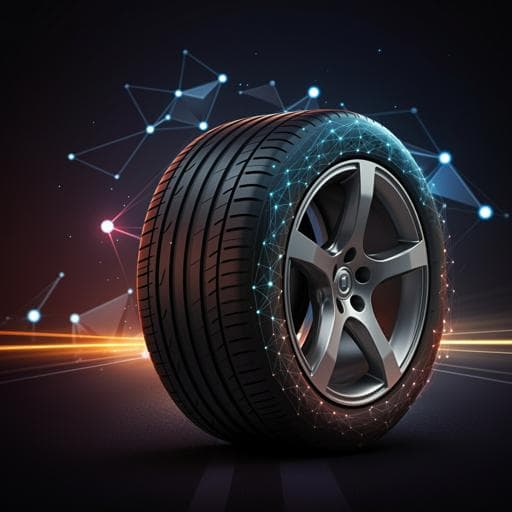
Engineering and Technology
3D printed graphene-based self-powered strain sensors for smart tires in autonomous vehicles
D. Maurya, S. Khaleghian, et al.
Discover an innovative tire-integrated system that combines 3D printed graphene-based strain gauges and a piezoelectric energy harvester for continuous monitoring of tire-road interactions! This cutting-edge research by esteemed authors addresses critical advancements for autonomous vehicles, emphasizing cost-effectiveness and self-powered sensing capabilities.
~3 min • Beginner • English
Introduction
There is strong commercial momentum toward autonomous vehicles, which necessitates robust smart tire systems capable of real-time monitoring of tire–road interactions to meet safety standards. Smart tires should incorporate embedded, self-powered sensors with high-frequency, secure data transmission for real-time control. Conventional solutions often rely on rigid, externally powered sensors and multistep integration, increasing cost and complexity. Graphene-based sensors have shown high sensitivity and performance, and 3D printing can simplify fabrication and reduce cost (approximately $2.7 per sensor reported here). Existing in-tire TPMS typically transmits infrequently (e.g., one message per 60 s) to conserve battery and lacks message authentication, making it vulnerable to spoofing. This work demonstrates 3D-printed graphene strain sensors integrated in tires, piezoelectric energy harvesting for self-powering, and a secure wireless data transfer method, along with modeling and machine learning for parameter estimation, addressing key needs for autonomous vehicle safety and control.
Literature Review
Prior work integrates wireless sensors in tires to measure dynamic mechanical parameters, but many are rigid, battery-powered, and fabricated via time-consuming processes. TPMS provides low-rate, battery-constrained pressure monitoring without security, leaving communications vulnerable. Graphene-based strain sensors are promising due to high sensitivity and flexibility. 3D printing enables rapid, cost-effective fabrication on diverse substrates. The study builds upon these advances, replacing conventional rigid sensors and insecure TPMS messaging with flexible, 3D-printed graphene sensors and secure, energy-harvesting-powered wireless systems.
Methodology
Sensor fabrication: Graphene oxide (GO)-based inks were formulated for aerosol-based 3D printing (AD2/Eden printer). GO sheets (characterized by TEM) were printed on substrates (e.g., Kapton) and chemically reduced to rGO to enhance conductivity. Five printing passes yielded ~10 µm thick films. Microstructural and structural characterization included XRD (GO peak at 2θ ≈ 11.11°, rGO peak at 2θ ≈ 25.7°), Raman spectroscopy (D, G, 2D, and D+G bands; increased ID/IG after reduction indicating new sp² domains and disorder), AFM and SEM (wrinkled microstructure for flexibility). Electrical response to bending was measured; strain was computed from substrate thickness and bend radius, showing near-linear resistance change up to ~0.7% strain. Time-dependent resistance under tensile strain was also examined.
Field integration and testing: 3D-printed rGO piezoresistive sensors were mounted inside a tire (Goodyear P245/70R17) on a mobile test rig. Data were collected along a ~300 m route (A–B–A runs ~600 m; >100 passes total). Sensors experienced 8031 cycles. Experiments varied vehicle speed (5, 10, 20 mph), normal load (2000, 3000, 4000 N), and tire pressure (20, 25, 28 psi). A 9 V supply was applied across the sensor in series with an equivalent resistor; output voltage variations due to resistance changes were acquired via LabVIEW.
Modeling and simulation: Tire modeled as an inextensible ring on radial and tangential springs. Parameters (flexural rigidity, radial and tangential stiffness) were identified by matching measured tire modal frequencies; estimated values were ~63.6 N/m (flexural rigidity), 1562 kN/m² (radial stiffness), 2212 kN/m² (tangential stiffness). Damping ratio of 0.1 assumed. A series solution for in-plane deflection ψ(θ,t) expanded in Fourier modes; governing PDEs reduced to ODEs for modal coordinates under rotation rate Ω and radial load q_w. Strain at the sensor plane (height z2 from neutral layer) was computed and assumed fully transferred to the sensor (negligible interface damping, negligible sensor mass/stiffness effects). Simulations predicted strain vs. time and radial displacement vs. angular position at the tested speeds, loads, and pressures.
Machine learning: A two-layer feed-forward neural network with six hidden neurons was trained to estimate tire pressure using features including normal load, longitudinal velocity, and a waveform parameter V1 derived from the sensor signal and its time derivative. Dataset: 1023 tire revolutions from the portable trailer; split: 70% training, 15% validation, 15% testing. Performance assessed via correlation coefficient and error histogram.
Energy harvesting and secure wireless data transfer: A PVDF piezoelectric patch (3 cm × 7 cm) mounted on a tire piece was excited (e.g., 13 Hz) to harvest energy, stored in a 5 μF capacitor to power a commercial wireless sensor node (MIDASCON). The system wirelessly transmitted tire temperature and humidity to a smartphone app; peak power vs. load resistance characterized. For security, an energy-efficient mechanism was proposed: cache messages and their computed authentication information; when measurements repeat (common in normal events), reuse prior authentication to avoid recomputation, reducing security computation overhead compared with conventional per-message authentication and encryption. Wireless powering and secure transmission feasibility were demonstrated.
Key Findings
- Cost-effective fabrication: 3D-printed graphene strain sensors cost ~US$2.7 per sensor and can be directly printed and reduced to rGO, yielding homogeneous, wrinkled microstructures for flexibility.
- Structural/electrical characterization: GO to rGO conversion confirmed by XRD (GO 2θ ≈ 11.11°, rGO 2θ ≈ 25.7°) and Raman (increased ID/IG indicating new sp² domains). Nearly linear resistance–strain response up to ~0.7% strain during bending.
- Durability and field readiness: Sensors operated over 8031 cycles in field tests on a mobile tire rig, covering >100 runs of ~600 m each.
- Sensing performance vs. operating conditions: At 4000 N load and pressures 20–28 psi, peak voltage amplitudes decreased with increasing speed (5 → 20 mph) for both tensile and compressive zones; compressive peaks dominated at 4000 N. Lower pressures led to higher strain/displacement amplitudes; higher loads increased peak strain at fixed speed/pressure. The sensor measured strains on the order of 3000–6000 μstrain.
- Modeling–experiment agreement: Simulated strain/displacement trends matched experimental observations across speed, load, and pressure; radial displacement increased as pressure decreased, for a given load/speed.
- Machine learning pressure estimation: Two-layer NN (6 hidden neurons) trained on 1023 revolutions achieved high correlation: Training R = 0.96516, Validation R = 0.94925, Test R = 0.97847, All R = 0.96481. Error histogram centered near zero, indicating accurate pressure estimation; waveform parameters V1 and V4 increased with lower pressure or higher load, and were relatively insensitive to speed.
- Self-powered secure wireless: PVDF (3×7 cm) piezo harvester charging a 5 μF capacitor powered a wireless node that transmitted temperature/humidity to a smartphone. Proposed caching-based security mechanism substantially reduced computation overhead versus conventional per-message security at comparable transmission rates, enabling secure communication under energy constraints.
Discussion
The work addresses the need for embedded, self-powered, and secure sensing in smart tires for autonomous vehicles. By leveraging 3D-printed rGO sensors with compliant microstructures, the system captures tire strain signatures that encode load, pressure, and speed effects. Experimental results across realistic operating ranges (5–20 mph, 2000–4000 N, 20–28 psi) show clear, interpretable waveform changes; modeling of the tire as a ring-spring system reproduces these trends, supporting the interpretation that decreasing pressure and increasing load elevate strains. Machine learning exploits robust waveform features (e.g., V1) that are sensitive to load/pressure but relatively invariant to speed, enabling accurate pressure estimation with high correlation metrics. Integrating a PVDF harvester demonstrates practical self-powering for wireless transmission. The proposed security mechanism leverages redundancy in normal operating conditions to amortize authentication costs, meeting energy budgets for low-power nodes. Together, these results demonstrate a viable pathway to real-time, self-powered, secure smart tire sensing suitable for integration with autonomous vehicle control systems.
Conclusion
This study presents an integrated smart tire platform featuring direct 3D-printed graphene (rGO) piezoresistive strain sensors, physics-based modeling, machine-learning pressure estimation, and self-powered secure wireless communication via piezoelectric energy harvesting. The sensors are low-cost, flexible, and durable, exhibiting linear response at low strains and robust operation over thousands of cycles. Modeling corroborates experimental trends across loads, pressures, and speeds, and a compact NN achieves accurate pressure estimation. A PVDF-based harvester powers wireless telemetry, and a caching-based security approach reduces computational overhead, making secure transmissions feasible under stringent energy constraints. Future work could include: long-term durability studies under extended mileage and environmental extremes; scaling to multi-sensor arrays for richer tire–road interaction mapping; closed-loop integration with vehicle control; and refined tire models capturing transient dynamics and sensor–tire coupling effects to enhance prediction accuracy.
Limitations
- Modeling assumptions include an inextensible tire ring, negligible effect of the graphene sensor on tire dynamics, full strain transfer with negligible interface damping, and a uniform damping ratio (0.1) across modes; these simplifications may limit quantitative accuracy under complex transients.
- Experimental speed range (5–20 mph) and discrete loads/pressures may not capture all on-road conditions (e.g., high-speed highway driving, cornering, varying temperatures, wet surfaces).
- Energy harvesting demonstrations used a shaker excitation and a separate cart/walk-mill setup; integrated in-tire harvesting performance across a full vehicle duty cycle and environmental conditions was not fully characterized.
- Security evaluation was based on energy measurements and a proposed caching mechanism; end-to-end in-vehicle cybersecurity assessment (e.g., against active adversaries) remains to be demonstrated.
- Some materials processing details suggest variability (e.g., ink chemistry and reduction), which could affect reproducibility and sensor-to-sensor consistency without further process control.
Related Publications
Explore these studies to deepen your understanding of the subject.







